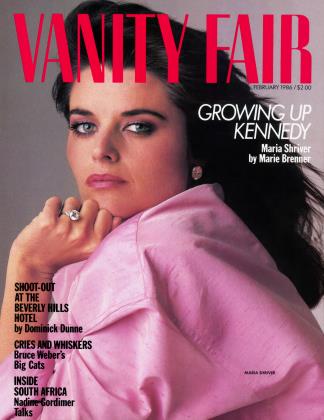Sign In to Your Account
Subscribers have complete access to the archive.
Sign In Not a Subscriber?Join NowHomage to Wine Master
Vintage Point
JOEL L. FLEISHMAN
This year marks the twentieth anniversary of Hugh Johnson's Wine, the first English-language wine book to achieve major success in the mass market. Approximately 800,000 copies have been sold in seven languages. It wasn't a bad start for a twenty-seven-year-old author, and in the intervening years Johnson has become one of the most distinguished figures in the world of wine. He is certainly the most widely read wine writer in English. His first volume was followed by many books, including Hugh Johnson s Wine Companion, republished in the United States as Hugh Johnson s Modern Encyclopedia of Wine.
It is not too mighty a stretch to suggest that it was in part Hugh Johnson's success as a wine columnist, starting fresh out of Cambridge with Conde Nast in 1960, that created the new calling of wine journalism. There are now many compendiums on wine, and many pocket guides similar to his Pocket Encyclopedia of Wine. Even his new "how to'' volume, How to Enjoy Wine, published not only in print but also in fifty-four-minute videocassette and audiocassette forms, is not unique.
Johnson's World Atlas of Wine, however, which evolved from his travel writing for the Sunday Times of London, is sui generis. First published in 1971, it was—and still is—the only comprehensive atlas of all the world's great wine-making regions. It has already sold two million copies worldwide, and last fall it went into its third edition. The new volume is only thirtytwo pages longer than the second edition, but American wine enthusiasts will be happy to learn that California claims almost one-quarter of the additional pages. All the maps are now printed by a four-color process, yielding much greater depth and detail, and they are drawn to Johnson's specifications. Burgundy's Cote d'Or has newly plotted maps, reflecting recent French-government surveys, and for the first time it is possible to see which vineyards in Bordeaux belong to Cru Classe chateaux. The California maps show officially designated viticultural areas, the American version of the French Appellation Controlee.
While Johnson is justifiably proud of his World Atlas, he does have a bone to pick with his American publishers. He cannot abide the American book jacket. "This time the Americans put a halffilled wineglass on it, dangerously and erroneously tilted!"
Johnson lives with his wife, Judy, and their three children in Saling Hall, part of which dates back to the sixteenth century, on a twelve-acre Essex estate. When he is in London he is based in a pied-a-terre on St. James's Street, on the same block with several of the best wine merchants in London, including the venerable Berry Bros, and Rudd. More important to Johnson, his flat is a two-minute walk to Green Park, a treelined expanse of manicured grass, plants, and flowers.
It is not surprising that Hugh Johnson chose a London base that lies cheek by jowl with both the best wineshops in London and the human-scale jewel of London's great green open spaces. His passion for gardens provides, he says, his principal relaxation, although he goes about relaxing with virtually the same level of energy he pours into his profession of wine. Not only is he a member of the Royal Horticultural Society, but he also serves as the editorial director of its authoritative journal, The Garden, and writes, under the pseudonym of Tradescant, § who was King Charles I's gar| dener, a monthly column for it. o To his credit also are several vol| umes on horticulture, including the widely admired Principles of Gardening.
Like Samuel Johnson before him, Hugh Johnson is passionate about his wordsmanship; he even writes the captions in his books ("the most important parts, because they are the only words some people read"). Encyclopedist (so called against his will), historian (Johnson is now at work on a world history of wine), cartographer, horticulturist, editor, wine judge, world traveler, prose stylist, wit, and raconteur, Hugh Johnson is every bit as diverse an eminence as Samuel was in his century. Later this year he will launch a Hugh Johnson Collection of wine implements, to be sold both by mail and in specialty stores all over the world. Just as he personally crafts his books, so has he personally designed his collection. It embraces not only a seven-piece line of crystal handblown in Sweden—including the most graceful, ample egg-shaped red-wine glass I've ever beheld—but also an English-made, hand-blown reproduction of a classic eighteenth-century threering decanter, and many other, more predictable items. In the beginning, the Hugh Johnson Collection will offer twenty-five pieces, to which he expects to add about five a year, "as I find things that are beautiful and useful."
One hardly knows quite what to make of this one-man conglomerate with an encyclopedic command of two disparate fields. He is a soft-spoken, cultured, gentle, tweedy scholar of rare achievements. In the eighteenth century one was accustomed to such men; to us they seem in short supply.
 View Full Issue
View Full Issue


















Subscribers have complete access to the archive.
Sign In Not a Subscriber?Join Now